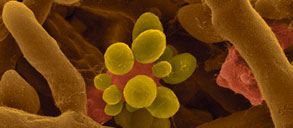Health Risks of Mold

Molds are organized into three main classifications based on their subsequent human responses:
Allergenic Molds
Allergenic Molds are not typically considered life-threatening and are most likely to affect those who are already allergic or asthmatic. The human system responses to allergenic Molds tend to be relatively mild, typically producing sore or scratchy throats, eye and nose irritations and rashes.
Pathogenic Molds
Pathogenic Molds tend to be associated with some type of infection. Those who suffer from a more suppressed immune system are mostly likely to experience more sever heath effects from these Molds. Healthy people can usually naturally resist infection. In rare cases, high exposure may cause hypersensitivity pneumonitis (an acute response to exposure to an organism).
Toxigenic Molds
Of the three, toxigenic Molds can cause the most serious health effects. Mycotoxins have toxic effects ranging from short-term irritation to immunosuppression and possibly cancer. Therefore, when toxigenic Molds are found, immediate evaluation is recommended.

How do Molds affect people?
Some people are sensitive to Molds. For these people, exposure to Molds can cause symptoms such as nasal stuffiness, eye irritation, wheezing, or skin irritation. People, such as those with serious allergies to molds, may have more severe reactions. Severe reactions may occur among workers exposed to large amounts of Molds in occupational settings, such as farmers working around Moldy hay. Severe reactions may include fever and shortness of breath. Some people with chronic lung illnesses, such as obstructive lung disease, may develop Mold infections in their lungs.
In 2004 the Institute of Medicine (IOM) found there was sufficient evidence to link indoor exposure to Mold with upper respiratory tract symptoms, cough, and wheeze in otherwise healthy people; with asthma symptoms in people with asthma; and with hypersensitivity pneumonitis in individuals susceptible to that immune-mediated condition. The IOM also found limited or suggestive evidence linking indoor Mold exposure and respiratory illness in otherwise healthy children. In 2009, the World Health Organization issued additional guidance, the WHO Guidelines for Indoor Air Quality: Dampness and Mold

Molds are simple, microscopic organisms present virtually everywhere, indoors and outdoors.
Molds produce negative health effects through inflammation, allergy or infection. Allergic reactions, including fever, are common after mold exposure. Symptoms of those exposed to toxic molds which issue mycotoxins both individually or in combination are:
- Immune system suppression
- Respiratory problems including asthma and infections
- Eye irritation with burning, watery or reddened eyes
- Cough – dry and hacking
- Nose or throat irritation or both
- Skin rashes or irritation
- Memory impairment
- Irritable bowel syndrome
- Body aches and pain (Chronic Fatigue)
- Food Intolerances and allergies
- Headaches
- Mood swings
- Nasal and sinus congestion
